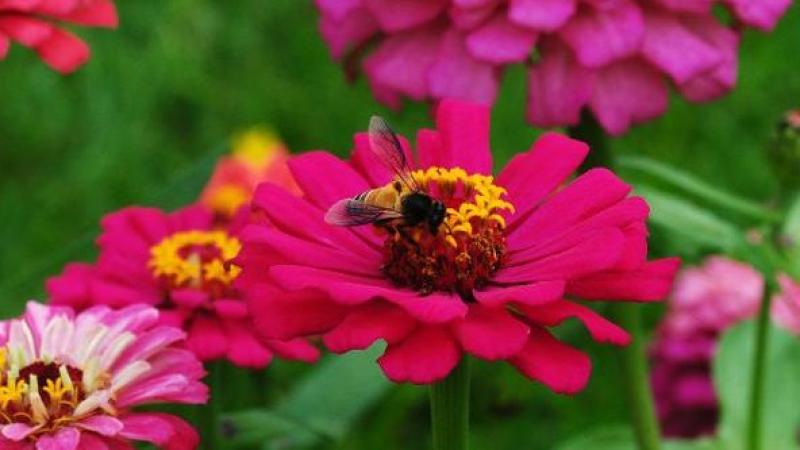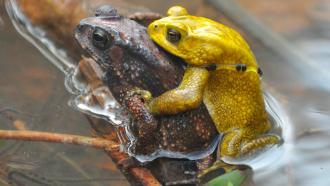
A colourful platter never fails to stimulate your appetite, right? The moment your eyes sense so many dishes laid out beautifully, the stomach starts to growl, and you want to grab a bite! But, you owe most of the food that you eat to insects that pollinate the grains, vegetables and fruits, thus ensuring there is food for all. Have you ever thought how these insects, which feed us, find their food? How do they decide which flower to forage? Do they also look for colours like us?
A new study by a team of researchers from the Indian Institute of Science Education and Research (IISER) Thiruvananthapuram, University of Exeter, United Kingdom and University of Sussex, United Kingdom have attempted to find out if insects indeed have colour preferences when they pollinate. Published in the journal The Science of Nature, the study looks into whether tropical and temperate bees differ in their colour preferences.
In nature, insects are thought to be inherently biased to some particular colours or have innate colour preferences, which helps them find nectar-rich flowers. Think of how a colourful garden attracts many butterflies! Insects are also able learners and through experience, are known to alter their colour choices to adapt to their changing environment. However, observing these natural choices in laboratory experiments is not easy! Hence, scientists study the responses of ‘colour-naïve’ insects, which have never foraged outside and therefore never seen colourful flowers. The colour preferences exhibited by these insects are called spontaneous colour preferences. In this study, the researchers studied the spontaneous colour preferences of temperate and tropical bees.
The researchers studied three species of bees; the eastern honeybee (Apis cerana), the stingless bee (Tetragonula iridipennis), and the bumblebee (Bombus terrestris). The eastern honeybee and the stingless bee are found in the tropics (tropical bees), and the bumblebee is a temperate bee. The authors conducted experiments on these bees in the IISER Thiruvananthapuram campus and the Streatham campus of the University of Exeter.
For the study, the researchers enclosed newly emerged individuals of all the three species of bees for some time and fed them. Thus, they became ‘colour naïve’ bees, which had never foraged on their own. They were then individually trained with the neutral UV-grey or pale yellow colour stimuli to motivate them to feed, and the researchers then observed their spontaneous colour preference during the experiments. In the case of pale yellow stimulus, a sucrose solution reward was given to see whether rewards can change their experience and thus, their colour preference.
The researchers also enclosed mature colonies of eastern honeybees for 2, 6, 8 and 9 weeks to see whether the experienced foragers still remembered the colour associations they had previously learned in the absence of any reward. The bees enclosed for 2, 6 and 8 weeks were trained to UV-grey stimulus while those confined for 9 weeks were trained to pale yellow stimulus and tested. The choice behaviour of the bees was recorded in a video and analysed.
Both the eastern honey bee (tropical bee) and the bumblebee (temperate bee) showed similar spontaneous colour preferences, while that of the stingless bee (another tropical bee) differed from both of them. In all the three species, their choice during the test was dominated by bluish-green colour when trained to UV-grey stimuli. Unlike in similar studies performed before, this study did not observe a sharp preference for a particular colour between the eastern honey bee and the bumblebee. When the test colours were seen regarding long-wavelength and short-wavelength, both of them showed similar preference to long wavelength colours, while the stingless bee showed no choice, contradicting previous studies which found that bees prefer short wavelength colours.
“This can be expected when presenting a larger number of colours, as colour generalisation and exploration of non-preferred colours are likely to occur. The number of colours offered and foraging experience, even without colour learning, could affect the outcomes of the test.” say the authors.
All three of them, when trained to pale yellow stimulus, preferred yellow and long wavelength colour. The eastern honey bees that were enclosed for 2 and 6 weeks preferred cyan, and those confined for 8 weeks preferred bluish-green. Overall, all the three groups showed more preference to short-wavelength colour. However, the bees from the colony enclosed for 9 weeks preferred yellow colour, which indicates that they had learnt to prefer this colour which was similar to the training stimulus. However, they showed no preference for either long or short wavelength colours.
The study found no difference between the spontaneous colour preferences of tropical and temperate bees. One reason for this observation could be the diversity in flower colour, meant to attract as many pollinators as possible. Also, this means that the spontaneous colour preferences do not have any adaptive value, i.e. they are not as a result of the bees’ adaptation to colour and reward properties of the flower.
Intriguingly, there was a difference in the preferences of the two tropical bees species, which the study considered as a result of resource partitioning amongst them, i.e. to avoid any overlap in their floral resources. When trained to stimuli with rewards, the colour preference of colour naive bees was determined by the newly gained colour experience, which shows that they had learnt that visiting this particular colour would be fruitful. In the case of the enclosed bees, it was difficult to pinpoint a specific reason for the preferences due to several possibilities.
“We could not identify the causes for this change, e.g. whether experienced foragers changed their preferences at an older age or as a result of colour deprivation, or whether a turnover from experienced to naive foragers was taking place, or indeed a combination of both.” speculate the authors.
Though the results of the study vary from previous experiments, it mentions that differences in experimental procedures could affect the behaviour of the individual bees and thus, induce different responses. The study provides an exciting insight into the spontaneous colour preferences within tropical bee species and between tropical and temperate bees species, which would help to understand the ecological interactions between plants and pollinators better. It suggests looking into how spontaneous preferences, learning processes and decision-making are linked in pollinating insects for future research. We surely have a lot to learn from these humble, yet complex creepy crawlies!






